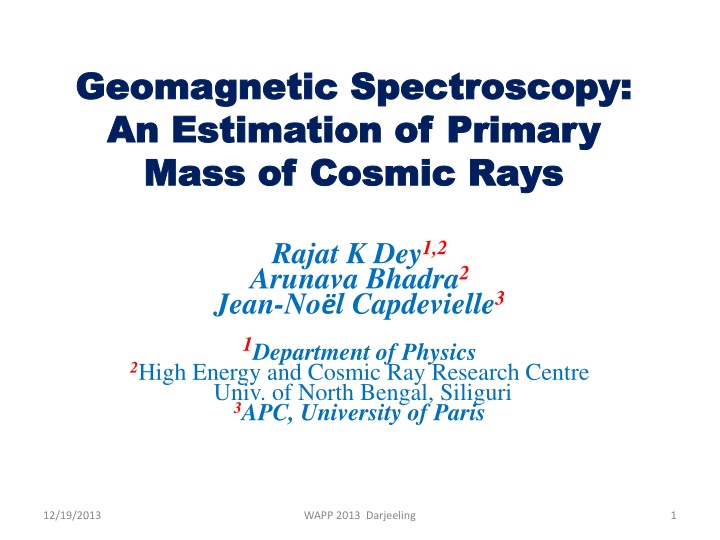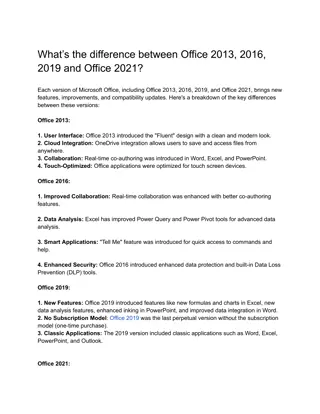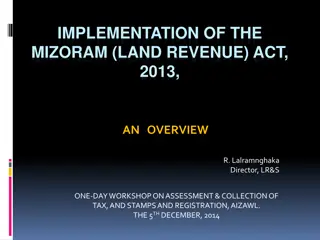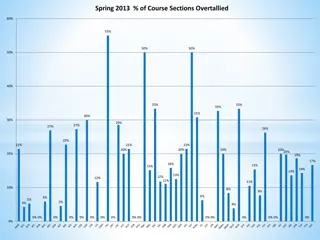
Estimation of Primary Cosmic Ray Mass Using Geomagnetic Spectroscopy
"Explore how the geomagnetic effect can be used to estimate the primary mass of cosmic rays. This study focuses on the pronounced impact of geomagnetic effects on muon components and its potential for discriminating between heavy nuclei and proton-induced showers through various parameters like muon distribution ellipticity, muon charge ratio, and muon dipole moment."
Download Presentation

Please find below an Image/Link to download the presentation.
The content on the website is provided AS IS for your information and personal use only. It may not be sold, licensed, or shared on other websites without obtaining consent from the author. If you encounter any issues during the download, it is possible that the publisher has removed the file from their server.
You are allowed to download the files provided on this website for personal or commercial use, subject to the condition that they are used lawfully. All files are the property of their respective owners.
The content on the website is provided AS IS for your information and personal use only. It may not be sold, licensed, or shared on other websites without obtaining consent from the author.
E N D
Presentation Transcript
Geomagnetic Spectroscopy: Geomagnetic Spectroscopy: An Estimation of Primary An Estimation of Primary Mass of Cosmic Rays Mass of Cosmic Rays Rajat K Dey1,2 Arunava Bhadra2 Jean-No l Capdevielle3 1Department of Physics 2High Energy and Cosmic Ray Research Centre Univ. of North Bengal, Siliguri 3APC, University of Paris 12/19/2013 WAPP 2013 Darjeeling 1
Introduction The perpendicular component of the GF causes the trajectories of secondary charged particles to become curved with positive and negative charged particles separating to form an electric dipole moment (Cocconi Phys Rev 1954), The geomagnetic broadening effect can be non-negligible in compare to the Coulomb scattering. 12/19/2013 WAPP 2013 Darjeeling 2
Some important effects arising out of geomagnetic effect The separation of electrons and positrons in an EAS by the geomagnetic field is believed to lead the radio emission in EAS (Allan 1970, Colgate 1967). The geomagnetic performance of ground-based gamma ray telescope (Hillas 1985, Bowden 1992). field affects the 12/19/2013 WAPP 2013 Darjeeling 3
GF induces an azimuthal modulation of the densities of air shower particles, particularly for large angle incidence (Allkofer et al 1985). The results of large scale anisotropy search by an EAS array will be affected due to GF if not the geomagnetic effect accounted for properly (The Pierre Auger collab., 2011) 12/19/2013 WAPP 2013 Darjeeling 4
Objectives: To explore whether geomagnetic effect can be utilized to estimate primary mass of cosmic rays. 12/19/2013 WAPP 2013 Darjeeling 5
Primary Geomagnetic spectroscopy The geomagnetic effect is more pronounced in muon component than electrons. From simulation study it appears that heavy nuclei and proton induced showers may be discriminated from i) the ellipticity of lateral muon distribution ii) the muon charge ratio (Capdevielle et al 2000) iii) the muon dipole moment (Capdevielle, Dey & Bhadra, 2011, 2013) mass composition from 12/19/2013 WAPP 2013 Darjeeling 6
Simulation procedure adopted Code: CORSIKA (Heck et al 1998) Version: 6.970 hadronic interaction models: High energy - EPOS 1.99 low energy (below 80 GeV/n UrQMD/FLUKA Curved option for high angle of incidence kinetic energy thresholds: 3MeV for electrons, 300 MeV for muons 12/19/2013 WAPP 2013 Darjeeling 7
Primaries: Proton and Iron arriving from different geographical directions: North, East, South, West. Primary energy (fixed) 1 PeV, 100 PeV 12/19/2013 WAPP 2013 Darjeeling 8
Data analysis: Correction due to i) geometric effect ii) attenuation effect 12/19/2013 WAPP 2013 Darjeeling 9
Hypothetical full coverage EAS array of area 300 m x 300 m Shower core at the centre of the array. 12/19/2013 WAPP 2013 Darjeeling 10
Results: Azimuthal variation for +and - 12/19/2013 WAPP 2013 Darjeeling 11
Azimuthal variation of charged muons for Fe primaries North direction East direction 12/19/2013 WAPP 2013 Darjeeling 12
Azimuthal variation of muon dipole length Butterfly approach 12/19/2013 WAPP 2013 Darjeeling 13
12/19/2013 WAPP 2013 Darjeeling 14
HE muon geomagnetic separation in very inclined EAS p Eo= 1 PeV Z = 75 , A= 0 Muon energy > 1 TeV 10 showers from North 10 showers from East 12/19/2013 WAPP 2013 Darjeeling 15
Primary N N (>1 TeV ) l(m) P 75 0 3160 12.5 54.6 65.8 P 75 90 3000 12.2 168.0 247 P 85 0 12760 17.8 405.6 86.4 Fe 65 0 7137 11.1 195.24 195.24 Fe 75 0 5030 19.1 81.3 84.8 12/19/2013 WAPP 2013 Darjeeling 16
Geomagnetic p primary Z = 75 , A= 0 Muon energy > 5 TeV separation Eo = 100 PeV 100 showers from of +, - 12/19/2013 WAPP 2013 Darjeeling 17
Geomagnetic Fe primary Z = 75 , A= 0 (North) Muon energy > 5 TeV separation = 100 PeV 100 +, showers from - Eo 12/19/2013 WAPP 2013 Darjeeling 18
Geomagnetic p primary Z = 75 , A= 90 Muon energy > 5 TeV separation = 100 PeV 100 of +, - Eo showers from 12/19/2013 WAPP 2013 Darjeeling 19
Conclusion Muon charge ratio in very inclined EAS should give an extra handle for estimating primary mass composition (as well as for testing high energy interaction models). Experimental realization appears feasible in view of (almost) complete separation of + and - -by large area muon detectors such as ICECUBE. 12/19/2013 WAPP 2013 Darjeeling 20
Thank you 12/19/2013 WAPP 2013 Darjeeling 21















